Beyond the island paradise: A show that looks at what binds art and ideas in the polyglot Caribbean
- Share via
In the galleries of Long Beach’s Museum of Latin American Art hangs an unusual map. On first impact, it looks like a seafaring map from the Age of Exploration, with its barely recognizable land forms and monster octopuses devouring a sailing ship.
But study it further and curious details emerge. There are the precise renderings of seaplanes and cruise ships. And soon the familiar outlines of the Caribbean Sea come into focus.
The map is a 2017 work by Haiti-born artist Jean-Ulrick Désert titled “The Waters of Kiskeya/Quisqueya.” Part of the Pacific Standard Time: LA/LA exhibition series, the map is on view at “Relational Undercurrents: Contemporary Art of the Caribbean Archipelago,” now in its final days at the museum.
One thing that makes Désert’s map so difficult to identify on first impact is that he has rendered the Caribbean Sea in white instead of the more familiar blue, so the water blends in with the landmasses around it. Moreover, a web of red lines dissects the water into a constellation of geometric shapes that mark the Caribbean’s maritime borders.
“All the red lines, they’re like shards of glass,” says the exhibition’s curator Tatiana Flores. “It’s the story of the Caribbean. Under indigenous people, this was one space, but it became so fragmented as a result of colonial history.”
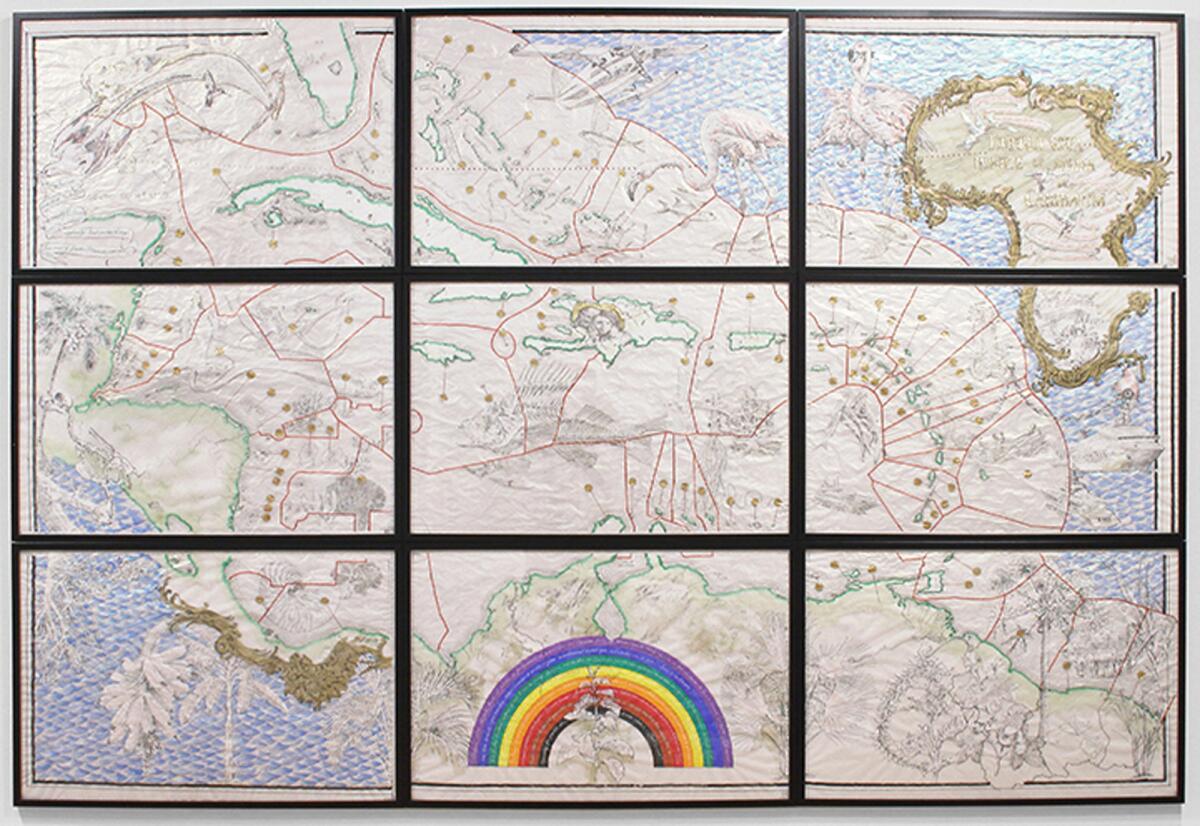
Under indigenous people, this was one space, but it became so fragmented as a result of colonial history.
— Tatiana Flores, curator
Désert’s map seems to undo the concept of what is Caribbean even as it defines it — pointing to the challenges facing any curator who seeks to tackle this unwieldy region, a place that is less land than water, and where reality, like the tides, always seems to be shifting.
“These are places that weren’t supposed to be places,” says Trinidadian artist Christopher Cozier via telephone from Port of Spain. “You have a location where competing European kingdoms created external labor camps to enrich themselves … It was where transplanted units of labor and raw materials came together.”
The Caribbean has mountains and lowlands; tropical weather and dry. It is home to people who bear indigenous, African, European and Asian roots and speak English, Dutch, Spanish, French and Kreyol. It was the site of one of the Western Hemisphere’s earliest independence struggles (the 1791 slave revolt that led to Haiti’s independence in 1804) and one of its last (Cuba, in 1898 — which came, in part, as a result of the Spanish-American War). Over the centuries, its myriad nations have been governed by colonial authority, distant monarchy, democracy, dictatorship and communist dictate.
“Relational Undercurrents” doesn’t seek to define the Caribbean, nor to capture the breadth of its experience. Instead, it zooms in on points of connection, looking for ideas that bind, rather than the red lines that divide. The result is a taut show, full of surprises, built around several themes that transcend language, politics and the old colonial divides — and that pierce the trope of island paradise.
“The Caribbean is so eclectic and so diverse to the point of being incomprehensible,” says Flores, who hails from Venezuela, a mainland country that borders the Caribbean Sea. “But there are undercurrents. I’m interested in the undercurrents.”
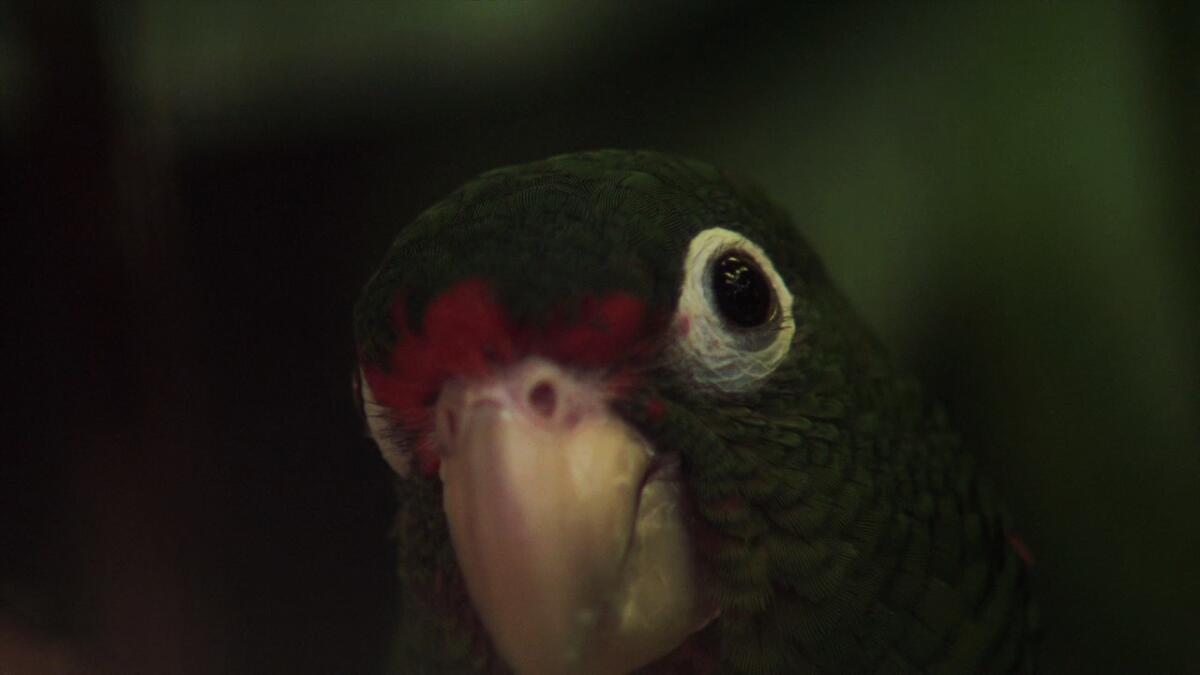
From its starting point of focus on Caribbean island nations and their shared waterscape, the exhibition narrows its lens further to four themes. The first of these is devoted to the ways in which Caribbean artists map their world.
This includes the large piece by Désert and an absorbing wall installation by Dominican artist Firelei Baez. “Man Without a Country (a.k.a. anthropophagist wading in the Artibonite River),” as the piece is titled, is composed of dozens of finely detailed drawings of fantastical women — many superimposed on old maps. Maps are documents of dominion. Baez’s figures are a reminder that imperial domination of the Caribbean wasn’t simply about land.
Other themes explored in the show include ecology and environment, the potency of the human figure in Caribbean art and the ways in which the horizon is employed as artistic device. This latter theme results in a number of poignant works.
The tourism industry, which plays a major role in Caribbean economies, frequently employs horizons in its postcard paradise imagery.
“The Caribbean is often presented as this one deserted beach that extends into infinity,” says Flores — a watery horizon offering regeneration and possibility.
But to the inhabitants of the region, the horizon has other, more profound meanings.
“Nothing can be put down in the sea,” said the late Nobel Prize-winning poet Derek Walcott, who hailed from St. Lucia, in a 1990 interview. “You can’t plant on it, you can’t live on it, you can’t walk on it. Therefore, the strength of the sea gives you an idea of time that makes history absurd … And by history I mean a direction that is progressive and linear.”
In the Caribbean, the sea is conveyance and alternate world.

These are places that weren’t supposed to be places. You have a location where competing European kingdoms created external labor camps to enrich themselves.
— Christopher Cozier, artist
Through a trick of film magic (or perhaps the well-placed edge of an infinity pool) a hypnotic video titled “Black Bullets” by Danish Trinidadian artist Jeannette Ehlers shows a series of black figures disappearing into a watery horizon as they descend a staircase.
Nearby, in a hallway gallery, hangs a kinetic sculpture by Cozier titled “New Level Heads.” Crafted out of cardboard and wood, the piece features a group of black heads bobbing in water.
Both pieces are hypnotic. They are also mournful, with echoes of the slave trade that brought so many Africans to the Caribbean, not to mention issues of environmental calamity, of a future in which water might swallow us all.
“I was trying to capture that sense of being suspended — not just of being afloat, but of a kind of tragedy,” Cozier says. “I wanted to underscore this idea. Islands are these separate entities floating in the open sea.”
These works intersect with others that dwell on the ways, both surreal and historical, in which Caribbean artists represent people.
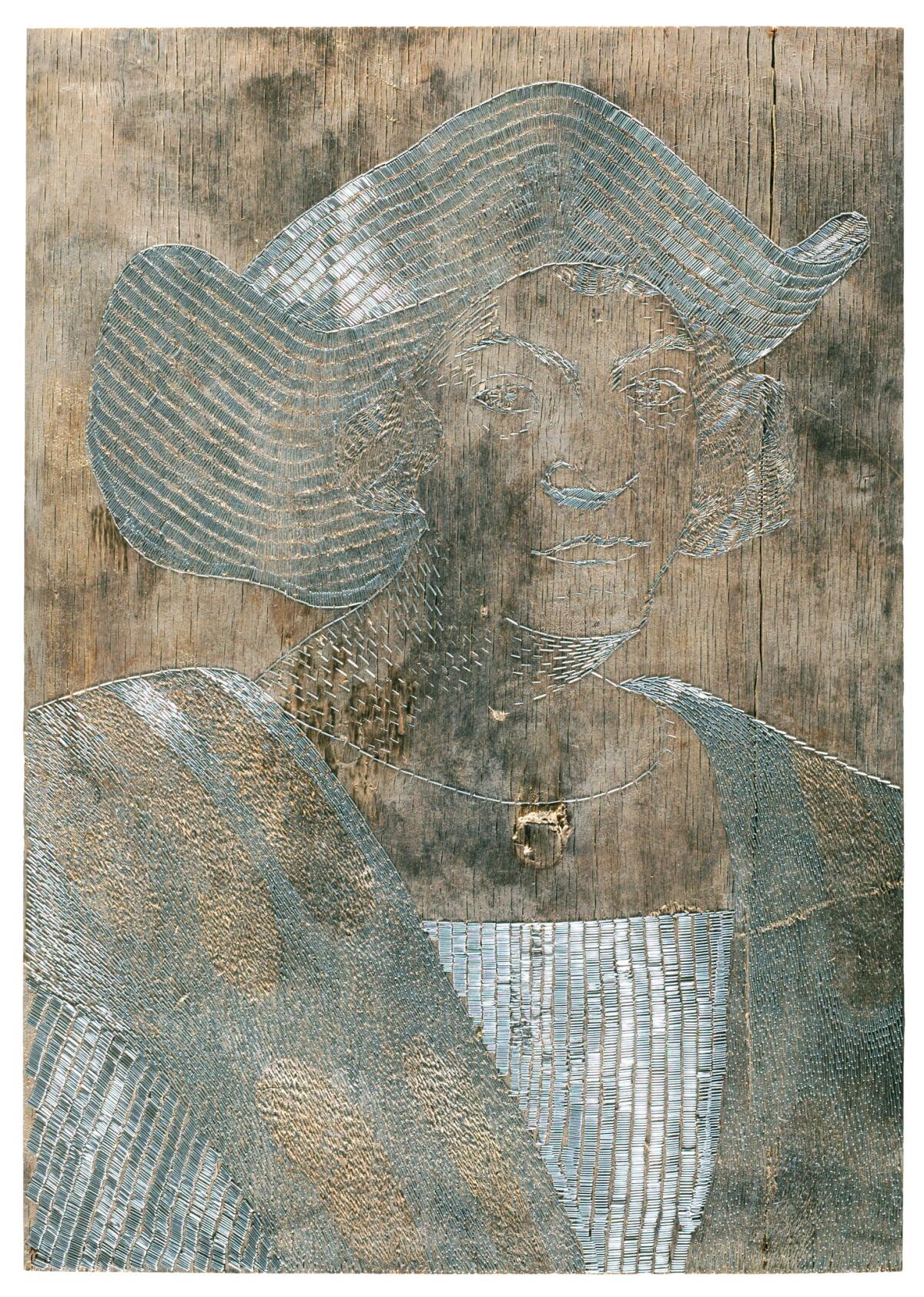
A piece by Swiss Haitian artist Sasha Huber renders Christopher Columbus in staples on wood, his glimmering visage only visible from certain angles. Curaçao artist David Bade features a lineup of cartoonish European archetypes seated on folding chairs. “My name is Europe,” states a line at the top. “Hi Europe,” reads the bottom — a 12-step meeting for those recovering from colonialism.
Especially beguiling is a canvas by Haitian American painter Didier William, who frequently renders inky black bodies — shadows, almost — engaged in strange choreographies. Some of these have skin that is covered in eyes.
“It’s a way for the figures in my paintings to return the curious gaze,” he says. “These figures can return the gaze not just with their eyes, but with every square inch of their skin.”
William was born in Haiti but raised primarily in the U.S. and now teaches at the Pennsylvania Academy of Fine Art. The Caribbean, he says, “is such a big space with so many histories” — among them, some immensely potent ones.
“I can never help but associate the Caribbean with one of the prime sites of black self-actualization: the Haitian Revolution,” he says via telephone from Philadelphia, where he is now based. “It’s this nucleus of black people naming themselves and establishing their own identity separate from their colonizers.”
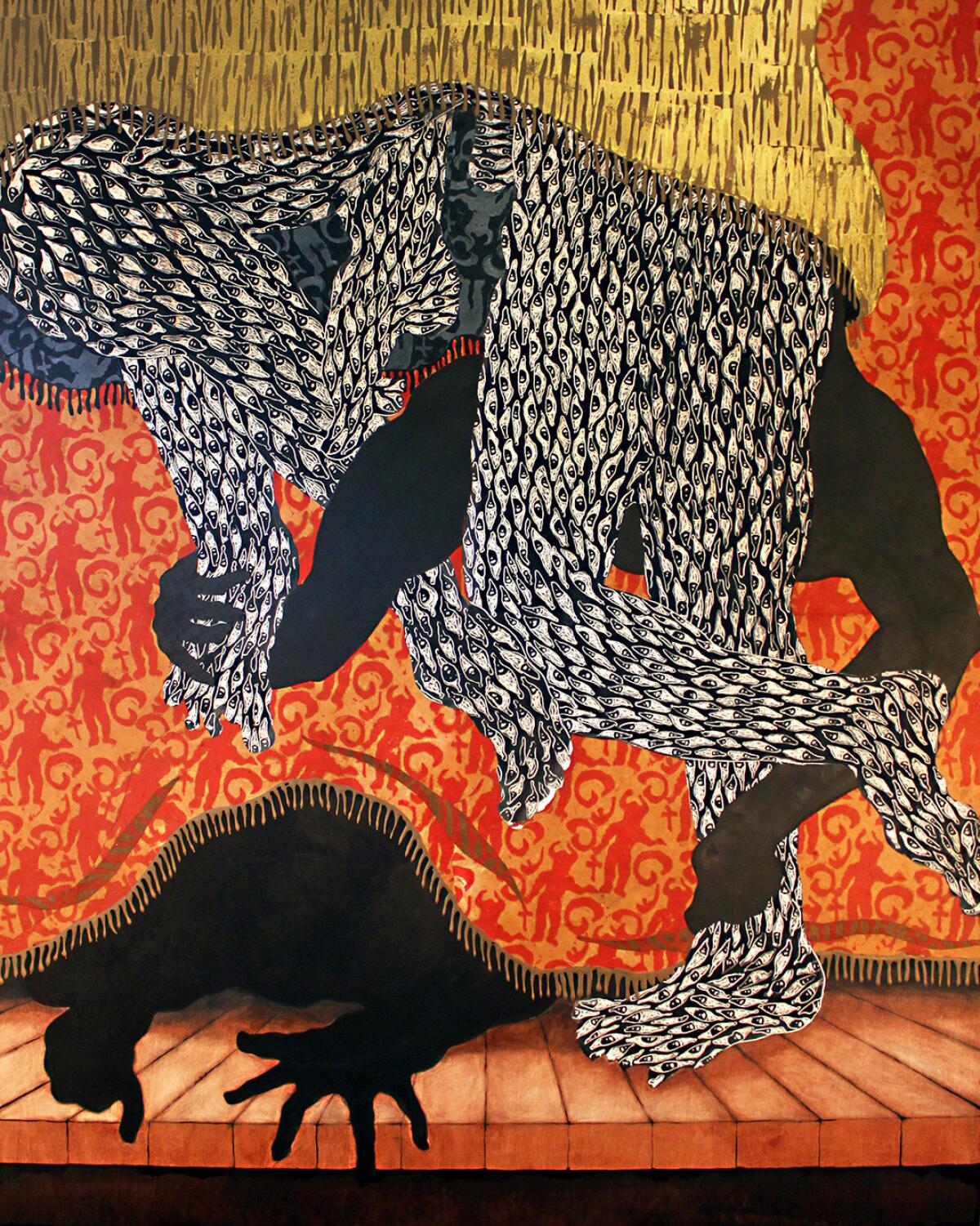
Exploring the use of the body in far more mordant ways is Puerto Rican Sofía Gallisá Muriente.
A video by the artist titled “Presente, Presente, Presente” explores the Puerto Rican phenomenon of “exotic wakes.” These unusual funerary viewings display the deceased not in a coffin, but in elaborate dioramas constructed especially for the event. This includes the dead placed on motorcycles or in the corner of a boxing ring.
Gallisá, who is based in San Juan, and serves as co-director of the artist-run nonprofit space Beta-Local, says she is interested in how these wakes might serve as the stuff of “new rituals” related to death.
“It is a market that grows out of the economic crisis,” she explains via email, “and out of the the wave of homicides that have accompanied it.”
There is a profound vulnerability to Gallisá’s all-too-human figures, who strike poses even as their bodies begin to decay. And, in fact, a strain of vulnerability is something that runs throughout “Relational Undercurrents.”
An installation by Dominican artist Tony Capellán, for example — who passed away suddenly after the MOLAA exhibition opened — consists of a blue color field made from plastic refuse: old detergent bottles and dish racks and children’s toys. Some of it is garbage he found floating in Dominican waterways. Other pieces are the detritus left behind by the shanties that are destroyed when hillsides collapse. The installation is remarkable for its room-size scale and for the potent ways it highlights the tenuous nature of human existence in the Caribbean.
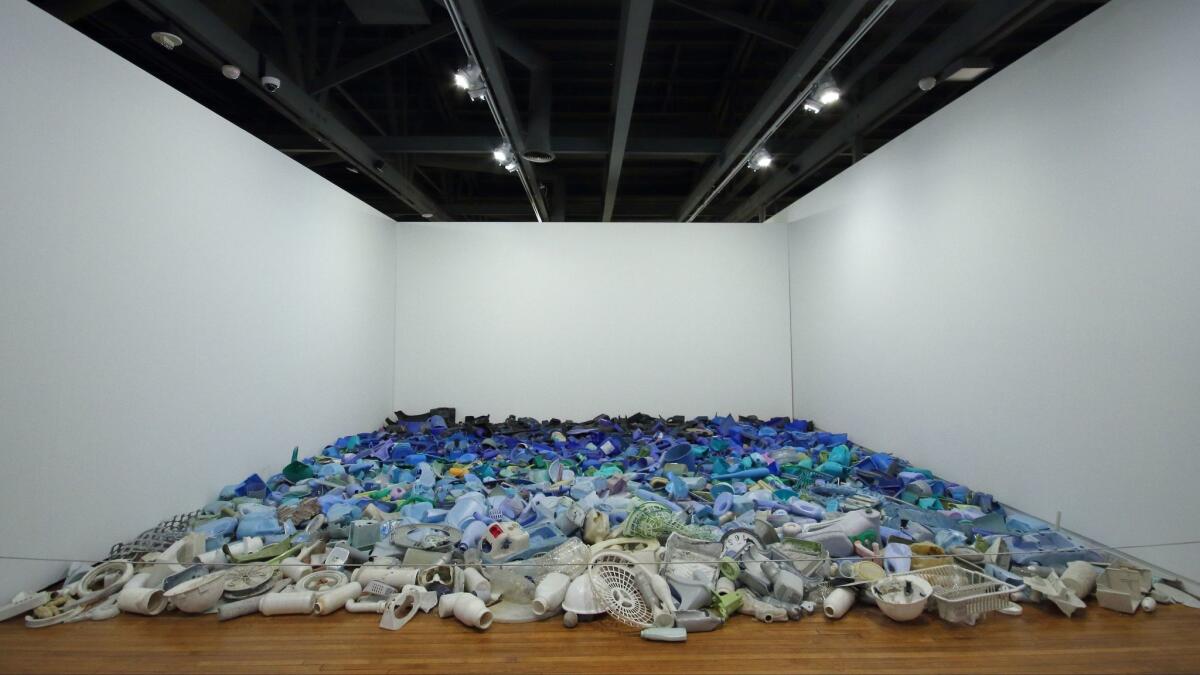
Nothing lasts in the Caribbean. I’ve thought about that since before Maria, but certainly the hurricane made it more evident than ever.
— Sofía Gallisá Muriente, artist
“Islands in the Caribbean don’t have the natural resources that could sustain a country like Brazil,” says Flores. “And colonialism has made them into these really vulnerable spaces: the smallness, the fragility, the vulnerability.”
The recent hurricane season, which pummeled Barbuda, St. Martin, Cuba and Puerto Rico, has made this all the more evident. It has laid bare systems of economic and political dependence to which many of the Caribbean islands are subject. Puerto Rico, for example, as a commonwealth of the United States, is bound by U.S. shipping laws such as the Jones Act, which limited (and still limit) the vessels that ferry relief to the island in the wake of Hurricane Maria.
Gallisá happened to be in Los Angeles for the opening of the MOLAA show when Maria struck. She was able to return only after nine days had passed (her suitcases stuffed full of emergency supplies).
“Maria has exposed, in extreme ways, a number of pre-existing conditions, including our lack of political power,” she says, “the fragility of our infrastructure and our vulnerability to savage capitalism and climate change.”
Through Beta-Local, Gallisá has been helping administer an emergency fund for Puerto Rican cultural workers. But the larger issues raised by the hurricane are something she is curious to address in her work.
“Nothing lasts in the Caribbean,” she adds. “I’ve thought about that since before Maria, but certainly the hurricane made it more evident than ever. Our region is marked by humidity, fungus, saltpeter, mold — fighting the weather to try to conserve material memory is a constant battle, one that, I think, is likely destined for failure.”
Decay, deterioration, inevitable regeneration. Out of calamitous history emerges culture. Nothing could be more Caribbean.
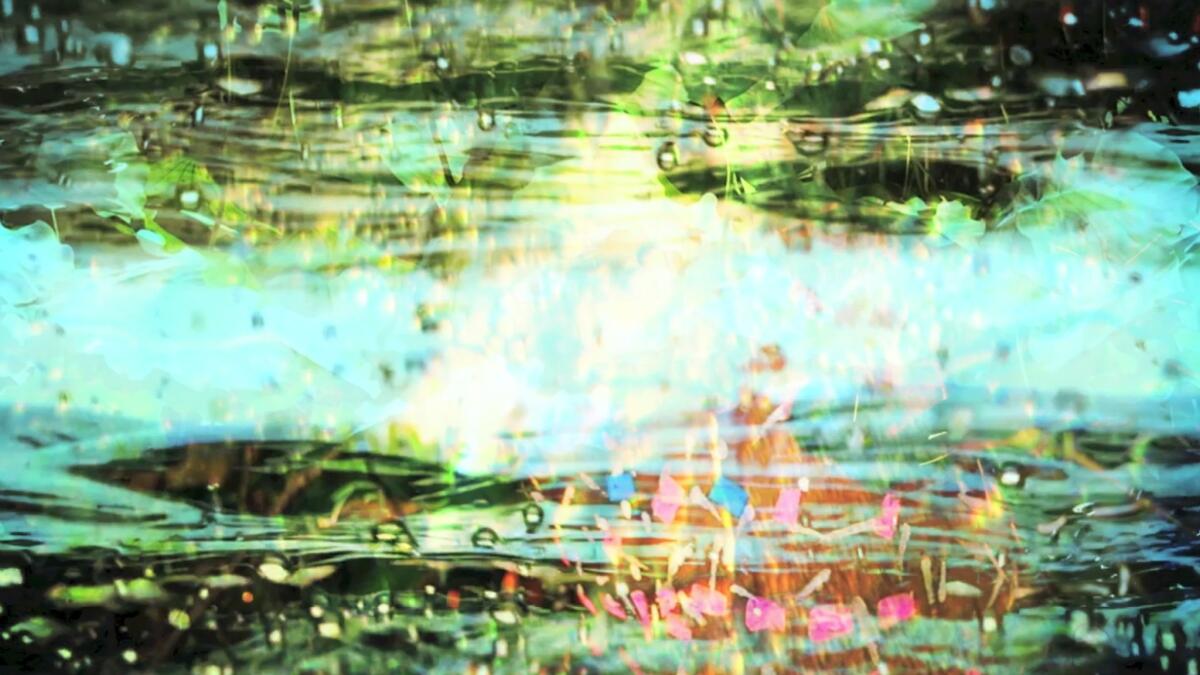
“Relational Undercurrents: Contemporary Art of the Caribbean Archipelago”
Where: The Museum of Latin American Art, 628 Alamitos Ave., Long Beach
When: Through March 4
Info: molaa.org
Sign up for our weekly Essential Arts & Culture newsletter »
ALSO
Is it inspired or irresponsible to call Donald Trump's border wall prototypes ‘art’?
For Quiara Alegría Hudes, a soldier's story leads to this remarkable feat: 3 plays on 3 L.A. stages
A Mexican actor became a worker making less than $5 a day for art, theater and understanding poverty
Art and teamwork help one Puerto Rican town nearly five months after Hurricane Maria ripped through
The biggest entertainment stories
Get our big stories about Hollywood, film, television, music, arts, culture and more right in your inbox as soon as they publish.
You may occasionally receive promotional content from the Los Angeles Times.








